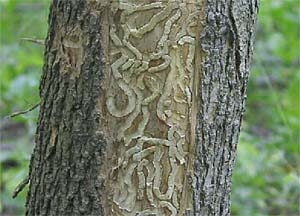Emerald Ash Borer Threatens County Ash Trees

Ash tree showing symptoms of damage from Emerald Ash Borer infestation
Ash trees in Fairfax County are steadily becoming the victims of an exotic pest, the Emerald Ash Borer. “The Emerald Ash Borer can now be found in all areas of the county, and we are no longer conducting any monitoring/trapping activities,” says Troy Shaw, chief of the county’s office of Forest Pest Management. “Unfortunately, we are starting to see severe ash mortality, and our efforts have shifted from monitoring to education in terms of treatment options.”
History of the infestation
In 2002, the Emerald Ash Borer was accidentally introduced into North America on shipments from Asia. The pest does not travel great distances on its own and is typically spread when ash materials, such as nursery stock, firewood and wood chips are transported from infested areas. It was first spotted in Fairfax County at Wolf Trap but was eradicated in 2005, according to Adria Bordas, Senior County Extension Agent. Frank Finch, a county Urban Forester, says the Emerald Ash Borer was again discovered in the county in 2008, and the county became a cooperator with the US Department of Agriculture and the Virginia Department of Agriculture and Consumer Services. An extensive trapping program was initiated to monitor the spread of the borer throughout the county and state. By 2012, the Emerald Ash Borer was found throughout the county, so monitoring was no longer necessary.
Identifying the enemy
Since trapping data indicates that all ash trees in Fairfax County are at risk, it is wise to know how to spot Emerald Ash Borer activity.

Emerald Ash Borer adults range from 7.5 to 13.5 mm in length. Nearby exit hole has distinctive D shape.
Symptoms of infestation include dead branches near the top of a tree, leafy shoots sprouting from the trunk, bark splits exposing larval galleries, extensive woodpecker activity, and the D-shaped exit holes. Ash trees with low population densities of Emerald Ash Borer often have few or no external symptoms of infestation.
Treatment options

Tunnels under bark are signs of damage by Emerald Ash Borer larvae. When a limb or trunk is “girdled” by tunnels, it dies.
The Fairfax County Urban Forest Management Division discourages the planting of ash trees for landscaping purposes, instead encouraging residents to plant a variety of other native trees that will increase a neighborhood’s resilience to future pest problems. Trees can be saved if they are showing only few outward signs of Emerald Ash Borer infestation. Decide if your trees are valuable to you and if they are vigorous and healthy and are enhancing your landscape. However, if more than half of the leaves are missing, no treatment will revive them. All infested trees should be removed as soon as possible.
Federal and state EAB quarantine
There is a federal contiguous Emerald Ash Borer quarantine throughout parts of the Eastern and Midwestern United States. The following items may not be moved out of the quarantined areas without a compliance agreement. These include all hardwood firewood, ash nursery stock, ash green timber, and any other ash material, living or dead, cut or fallen, including logs, stumps, branches, and roots as well as composted and uncomposted chips from any species of ash. Please call the Virginia Department of Agriculture and Consumer Services at 804-786-3515 for more information about compliance agreements.
References
Fairfax County Forest Pest
Emerald Ash Borer, USDA, Animal and Plant Health Inspection Service
Emerald Ash Borer, Emerald Ash Borer, Multistate and Multinational Coalition, Don’t Move Firewood.org
Emerald Ash Borer, Multistate and multinational coalition